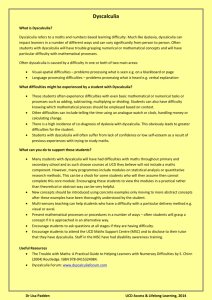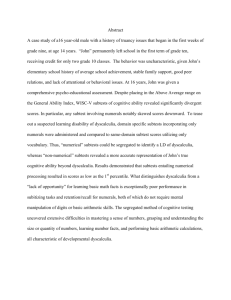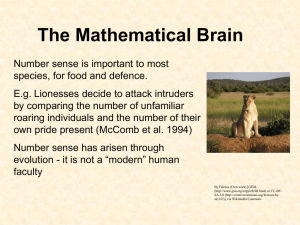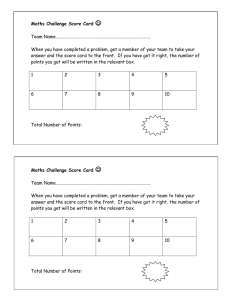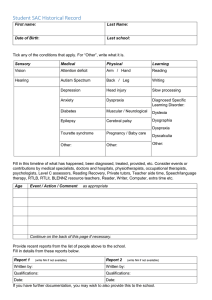Policy, Research, Identification and Intervention
advertisement
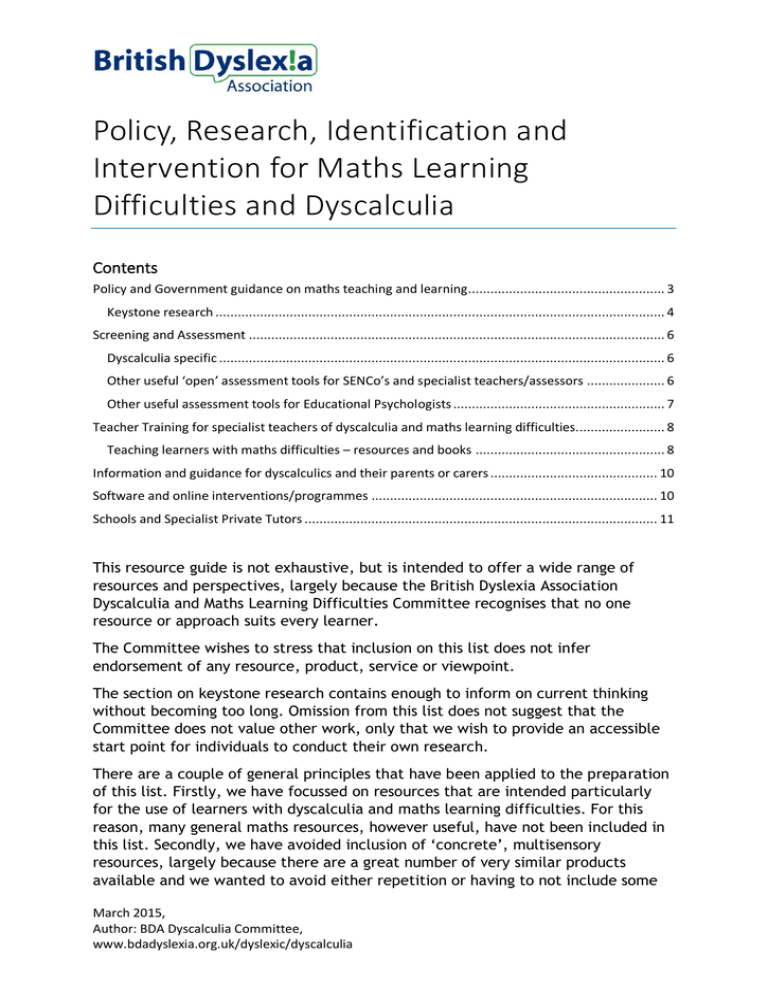
Policy, Research, Identification and Intervention for Maths Learning Difficulties and Dyscalculia Contents Policy and Government guidance on maths teaching and learning ..................................................... 3 Keystone research ......................................................................................................................... 4 Screening and Assessment ................................................................................................................ 6 Dyscalculia specific ........................................................................................................................ 6 Other useful ‘open’ assessment tools for SENCo’s and specialist teachers/assessors ..................... 6 Other useful assessment tools for Educational Psychologists ......................................................... 7 Teacher Training for specialist teachers of dyscalculia and maths learning difficulties. ....................... 8 Teaching learners with maths difficulties – resources and books ................................................... 8 Information and guidance for dyscalculics and their parents or carers ............................................. 10 Software and online interventions/programmes ............................................................................. 10 Schools and Specialist Private Tutors ............................................................................................... 11 This resource guide is not exhaustive, but is intended to offer a wide range of resources and perspectives, largely because the British Dyslexia Association Dyscalculia and Maths Learning Difficulties Committee recognises that no one resource or approach suits every learner. The Committee wishes to stress that inclusion on this list does not infer endorsement of any resource, product, service or viewpoint. The section on keystone research contains enough to inform on current thinking without becoming too long. Omission from this list does not suggest that the Committee does not value other work, only that we wish to provide an accessible start point for individuals to conduct their own research. There are a couple of general principles that have been applied to the preparation of this list. Firstly, we have focussed on resources that are intended particularly for the use of learners with dyscalculia and maths learning difficulties. For this reason, many general maths resources, however useful, have not been included in this list. Secondly, we have avoided inclusion of ‘concrete’, multisensory resources, largely because there are a great number of very similar products available and we wanted to avoid either repetition or having to not include some March 2015, Author: BDA Dyscalculia Committee, www.bdadyslexia.org.uk/dyslexic/dyscalculia products. We all believe that multisensory approaches are an integral part of any teaching and learning programme and we feel that the advice and guidance given in many of the included books and resources will guide readers in the right direction with regard to the use of multisensory materials. This is a living document and will be regularly updated. If you have a resource that you think should be included in this list please contact Pete Jarrett (pete@tutorum.co.uk) in the first instance. If the Committee approves inclusion your resource will then be added. March 2015, Author: BDA Dyscalculia Committee, www.bdadyslexia.org.uk/dyslexic/dyscalculia Policy and Government guidance on maths teaching and learning Coben, D., et al. (2007). Effective Teaching and Learning. Numeracy. NRDC. London. Department for Education (2013). Subject Content GCSE Mathematics. Available online: https://www.gov.uk/government/publications/gcse-mathematics-subject-content-andassessment-objectives Accessed 20/1/15 Department for Education (2013). Statutory guidance: National curriculum in England: mathematics programmes of study. Available online: https://www.gov.uk/government/publications/national-curriculum-in-englandmathematics-programmes-of-study Accessed 20/1/15 Department for Education (2014). SEND Code of Practice. Available online: https://www.gov.uk/government/publications/send-code-of-practice-0-to-25 Accessed 20/1/15 Dowker, A. (2009). What works for children with Mathematical Difficulties. National Numeracy Strategies: Primary. Department of Children, Schools Families. Nottingham. You can download this publication and obtain further information at: www.standards.dcsf.gov.uk PISA (2010). Mathematics Teaching and Learning Strategies in PISA. OECD Publishing. Paris. OFSTED (2012). Mathematics: Made to Measure. Available online: http://www.slideshare.net/Ofstednews/mathematics-made-to-measure Accessed 20/1/15 OFSTED (2013). Effective Numeracy Support that makes a Difference. Case Study: New College, Durham. Available online: https://www.gov.uk/government/publications/effective-numeracy-support-that-makes-adifference Accessed 20/1/15 Swan, M. (2005). Standards Unit. Improving Learning in Mathematics. Challenges and Strategies. Available online: http://tlp.excellencegateway.org.uk/pdf/Improving_learning_in_maths.pdf Accessed 20/1/15 March 2015, Author: BDA Dyscalculia Committee, www.bdadyslexia.org.uk/dyslexic/dyscalculia Keystone research Boaler, J. (2011). The Elephant in the classroom: Helping children learn and love maths. Souvenir Press. London. Bransford, JD, Brown, AL and Cocking, RR (2000). How People Learn. Washington DC, Academy Press Butterworth, B (1999). The Mathematical Brain. MacMillan. London. Butterworth, B. Varma, S. and Laurillard, D. (2011). Dyscalculia: From Brain to Education. Science. Vol 332. 27th May 2011. 1049-1053 Chinn, S. (2009). Mathematics Anxiety in Secondary Students in England. Dyslexia. 15: 6168. October 2008 Chinn, S. Ed. (2015). The Routledge International Handbook of Dyscalculia and Mathematical Learning Difficulties. Routledge. London. Dehaenes, S. (2011). Number Sense. How the mind creates mathematics, revised and updated edition. OUP USA. Boston. Desoete, A and Stock, P (2011). Can we Predict Mathematical Disabilities from Abilities in Kindergarten? New York, Nova Science Publishers Gathercole, S.E. and Packiam Alloway, T. (2008). Working Memory and Learning. A practical guide for Teachers. Sage. London. Geary, D. (2010). Mathematical Disabilities: Reflections on cognitive, neuropsychological, and genetic components. Learning and individual Differences 20 (2010). 130-133. Geary, D. C. (2010). Mathematical learning disabilities. In J. Holmes (Ed.), Advances in Child Development and Behavior (Vol. 38, pp. 45-77). San Diego, CA: Academic Press. Geary, D. C., Hoard, M. K., Nugent, L., & Bailey, D. H. (2012). Mathematical cognition deficits in children with learning disabilities and persistent low achievement: A five year prospective study. Journal of Educational Psychology, 104, 206–223. Gelman, R. and Gallistel, C.R. (1986). The Childs Understanding of Number. Harvard University Press. Cambridge, Mass. Gillum, J. (2012). Dyscalculia: Issues for practice in educational psychology. Educational Psychology in Practice: theory, research and practice in educational psychology. 28:3. 287-297. Gillum, J. (2014). Assessment with Children who experience difficulty in mathematics. Support for Learning. 29:3. 275-291. Hattie, J. and Yates, G. (2014). Visible Learning and The Science of How We Learn. Routledge. Abingdon. Hunt, T.E., Clark-Carter, D. and Sheffield, D. (2011). The Development and Part Validation for a UK Scale for Mathematics Anxiety. Journal of Psychoeducational Assessment. Vol 29. 2011. 455-466 March 2015, Author: BDA Dyscalculia Committee, www.bdadyslexia.org.uk/dyslexic/dyscalculia Kaufmann, L. and von Aster, M (2012). The Diagnosis and Management of dyscalculia. Deutsches Ärzteblatt International 2012. 109:45. 767-778. Mareschal, D. Butterworth, B. and Tolmie, A. Eds. (2014). Educational Neuroscience. Wiley Blackwell. Chichester, West Sussex. Mazzocco, MMM and Berch, DB (2007). Why is Maths so Hard for Some Children? Baltimore, Paul H Brookes Ramaa, s and Gowramma, IP (2022) Dyscalculia among primary school children in India. DYSLEXIA, 8 (2), 67-85 Shalev, R. and Gross-Tsur, V. (2000). Developmental Dyscalculia. Paediatric Neurology. 2000. Vol.24. No.5. Usher, E. and Pajares, F. (2009). Sources of Self efficacy in mathematics: A validation Study. Contempory Educational Psychology 34 (2009) 89-101 Yeo, D. (2003). Dyslexia, Dyspraxia and Mathematics. Whurr Publishers. London. Young, C.B., Wu, S.S. and Menon, V. (2012). The Neurodevelopmental Basis of Math Anxiety. Psychological Science. Pub. Online: 20 March 2012. Available at: http://pss.sagepub.com/content/early/2012/03/23/0956797611429134 Accessed: 26th March 2012 March 2015, Author: BDA Dyscalculia Committee, www.bdadyslexia.org.uk/dyslexic/dyscalculia Screening and Assessment Dyscalculia specific Butterworth, B. (2003). The Dyscalculia Screener. GL Assessment. London. (Ages 6-14+) Chinn, S. (2012). More Trouble with Maths. A complete guide to identifying and diagnosing mathematical difficulties. Routledge. Abingdon. (Ages 7-adult) Emerson, J. and Babtie, P. (2010). The Dyscalculia Assessment. Continuum Publishing. (Primary, Secondary) Francis, T., Smith, G., Wareham, J. and Wood, H. (2013). Dyscalc Available online: http://www.educational-psychologist.co.uk/screening/dyscalculic/ Accessed 15/1/15 (age 14+) Dynamo Maths (online). Dynamo Profiler. Available online: http://dynamoprofiler.co.uk/. Accessed 11/1/15. (Ages 6-9) The Dyscalculia Centre (Online). The Dyscalculia Test. Available online: http://www.dyscalculia.me.uk/testing.html Accessed 11/1/15 (No age given) Trott, C. /Tribal (online). DysCalculium Screener. Available online: https://dyscalculia.advancelearningzone.com/index.php?option=com_content&view=articl e&id=2&Itemid=2 Accessed 12/10/13 (Ages 16+ to adult) Other useful ‘open’ assessment tools for SENCo’s and specialist teachers/assessors Arnold, C., Bowden, P., Talents, M., and Waldon, R. (2011). Sandwell Early Numeracy Test – Revised – SENT-R. Sandwell Inclusion Support Service. Sandwell. Clausen-May, T and Vappula, H. (2006, 2009). Progress in Mathematics. PiM. GL Assessment. London. Gillham, B. Hesse, K. and McCarty, C. (2012). Basic Number Screening Test. 4th Edition. Hodder Education. Abingdon. Gillham, B. and Knight, C. (2001). Basic Number Diagnostic. 3rd Edition. Hodder Education. Abingdon. GL Assessment (2012). Cognitive Abilities Test. CAT4. GL Assessment. London. Glutting, J. Adams, W. And Sheslow, D. (2000). WRIT: Wide range intelligence test. Wilmington, DE. Wide Range Inc. McCarty, C. and Cooke, C. (2014). Progress in Understanding Mathematics Assessment. Hodder Education. Abingdon. Reynolds, C.R. and Voress, J.K. (2007). Test of Memory and Learning. Second edition. Pro-ed. Austin, Texas. Smith, A. (1982). Symbol Digits Modalities Test. Western Psychological Services, Los Angeles. March 2015, Author: BDA Dyscalculia Committee, www.bdadyslexia.org.uk/dyslexic/dyscalculia Wilkinson, G.S. and Robertson, G.J. (2006). Wide Range Achievement Test 4. Lutz, FL. Psychological Assessment Resources, Inc. Williams, J. (2005). Mathematics Assessment for Learning and Teaching. Hodder Education. Abingdon. Vernon, P. Miller, K. and Izard, J. (1995). Mathematics Competency Test. Hodder Education. Abingdon. Vernon, P. and Miller, K. (1998). Graded Arithmetic Mathematics Test. 4th Edition. Hodder Education. Abingdon. Other useful assessment tools for Educational Psychologists Elliot, C.D., Smith, P. (2012). British Abilities Scale 3. BAS3. GL Assessment. London. Wechsler, D. (2008). Wechsler Adult Intelligence Scale–Fourth Edition. WISC-IV Pearson. San Antonio, TX. March 2015, Author: BDA Dyscalculia Committee, www.bdadyslexia.org.uk/dyslexic/dyscalculia Teacher Training for specialist teachers of dyscalculia and maths learning difficulties. The criteria for courses leading to Approved Teacher Status (ATS) for teachers specialising in dyscalculia and maths learning difficulties has now been set out by the British Dyslexia Association. Institutions that currently run appropriate courses, or intend to run appropriate courses are listed below: Bath Spa University - PG Cert TT7369 – Identifying and Overcoming Maths Difficulties Edge Hill University - PG Cert SpLD (Dyscalculia) – to run from September 2015 Teaching learners with maths difficulties – resources and books Adlam, F. (2012). Dyscalculia Matters. Effective ways of working with children who struggle with maths. Essential Resources. Invercargill. ADSHE (Online). Numeracy Resources for students with SpLD’s. Available online: http://adshe.org.uk/resources-from-liz-ahrends-award/2009/ Accessed 12/2/15 Ashlock, R.B. (2010). Error Patterns in Computation. Using error patterns to help each student learn. Tenth Edition. Allyn and Bacon. Boston. Attwood, T (2012). Dyscalculia Practice Activities. First and Best in Education. Corby. Bird, R. (2007). The Dyscalculia Toolkit: Supporting Learning Difficulties in Maths. Sage. London. Bird, R. (2009). Overcoming Difficulties with Number: Supporting Dyscalculia and Students Who Struggle With Maths. Sage. London Bird, R. (2011). The Dyscalculia Resource Book. Games and Puzzles for Ages 7 to 17. Sage. London. Butterworth, B and Yeo, D (2004). Dyscalculia Guidance. London: nferNelson. Butterworth, B. (online). Dyscalculia – Numberphile. Video. Available online: https://www.youtube.com/watch?v=p_Hqdqe84Uc Accessed 12/2/15. Chinn, S. (2006). The Trouble With Maths. A practical guide to helping learners with numeracy difficulties. Routledge Farmer. London. Chinn, S. (2009). What to do when you can’t …. (Series). Egon. Wakefield. Chinn, S. and Jarrett, P. (2012). Dyscalculia Lesson Checklist. In: Cochrane, K. and Saunders, K. Dyslexia Friendly Schools Good Practice Guide. British Dyslexia Association. Bracknell. Chinn, S and Ashcroft, R (2007). Mathematics for Dyslexics, Including Dyscalculia. Chichester. 3rd edn. Wiley March 2015, Author: BDA Dyscalculia Committee, www.bdadyslexia.org.uk/dyslexic/dyscalculia Clausen-May, T. (2013). Teaching Mathematics Visually and Actively 2nd Edition. Sage. London. Cochrane, K. and Saunders, K. (2012). Dyslexia Friendly Schools Good Practice Guide. British Dyslexia Association. Bracknell. Emerson, J. and Babtie, P. (2014). The Dyscalculia Solution. Bloomsbury. London. Hannell, G. (2012). Dyscalculia – Action Plans for Successful Learning in Mathematics. Routledge. London. Hansen, A. Ed. (2014). Children’s Errors in Mathematics. 3rd Edition. Leaning Matters. London. Henderson, A. (2012). Dyslexia, Dyscalculia and Mathematics: A Practical Guide. Routledge. London. Hornigold, J. (). Dyscalculia Lesson Plans: Comprehensive Exercises to Support Mathematics Learning Difficulties. Special Direct.com. Kirkby-in-Ashfield. OUP (Online). Numicon. Primary Maths Resources. Available Online: https://global.oup.com/education/content/primary/series/numicon/;jsessionid=FB36594 C43A118F2310CFE62498D1460?region=uk Accessed: 11/1/15 Power of two (Online). Power of Two resources. Available online: http://www.powerof2.co.uk/ Accessed: 11/1/15 TES Connect (online). Dyscalculia Resource Treasure Collection. Available online: https://www.tes.co.uk/teaching-resource/Dyscalculia-Resource-Treasure-Collection6302884 Accessed 11/1/15 March 2015, Author: BDA Dyscalculia Committee, www.bdadyslexia.org.uk/dyslexic/dyscalculia Information and guidance for dyscalculics and their parents or carers Chinn, S (2011). The Fear of Maths. How to Overcome it. Sum Hope3. Souvenir Press. London. Moorcraft, P. (2014). It Just Doesn’t Add Up. Explaining Dyscalculia and Overcoming Number Problems for Children and Adults. Filament Publishing Ltd. Croydon. Software and online interventions/programmes Addacus LTD (online). Beat Dyscalculia. Available online: http://beatdyscalculia.com/ Accessed 11/1/15 CatchUp.org (online). CatchUpNumeracy. Available online: http://www.catchup.org/CatchUpNumeracy/CatchUpNumeracy.aspx Accessed 1/2/15 Chinn, S. (Online). Maths Explained. Available online: https://www.mathsexplained.co.uk/ Accessed 1/2/15 Dybuster (Online). Dybuster Calcularis. Available online: http://www.calcularis.ch/int Accessed 11/1/15 Dynamo Maths (Online). Dynamo Maths. Available online: http://www.dynamomaths.co.uk/ Accessed 11/1/15 IXL Learning (online). IXL Available online: http://uk.ixl.com/math/ Accessed: 11/1/15 Laurillard, D and Baajour, H. (Online). Numbersense. Available online: http://numbersense.co.uk/index.html Accessed 11/1/15 Nessy (online). Nessy Numbers. Available online: http://www.nessy.com/uk/product/nessy-numbers/ Accessed 11/1/15 NumberGym (Online). NumberGym. Available online: www.numbergym.co.uk Accessed 1/2/15 Pearson (Online). Rapid Maths. Available online: http://www.pearsonschoolsandfecolleges.co.uk/Primary/Mathematics/AllMathematicsres ources/RapidMaths/RapidMaths.aspx Accessed 1/2/15 Renlearn (Online). Accelerated Maths. Available online: http://www.renlearn.co.uk/accelerated-maths/ Accessed 1/2/15 Scholastic (online). FASTT Maths. Available Online: http://www.scholastic.com/fasttmath/index.htm Accessed 1/2/15 Whitespace (Online). Numbershark. Available online: http://www.wordshark.co.uk/numbershark.aspx Accessed 11/1/15 March 2015, Author: BDA Dyscalculia Committee, www.bdadyslexia.org.uk/dyslexic/dyscalculia Schools and Specialist Private Tutors Council for the Registration of Schools Teaching Dyslexic Pupils (CReSTeD): http://www.crested.org.uk/ Professional Association of Teachers of Students with Specific Learning Difficulties – Tutor/Assessor Index: https://www.patossdyslexia.org/SupportAdvice/TutorAssessorIndex/ This list was compiled by Pete Jarrett (www.tutorum.co.uk), a member of the BDA’s dyscalculia committee, with contributions from Dr James Gillum and the other members of the committee, Dr Steve Chinn (Chair) Prof Brian Butterworth, Clare Trott, Jill Higginson and Kate Saunders. March 2015, Author: BDA Dyscalculia Committee, www.bdadyslexia.org.uk/dyslexic/dyscalculia
